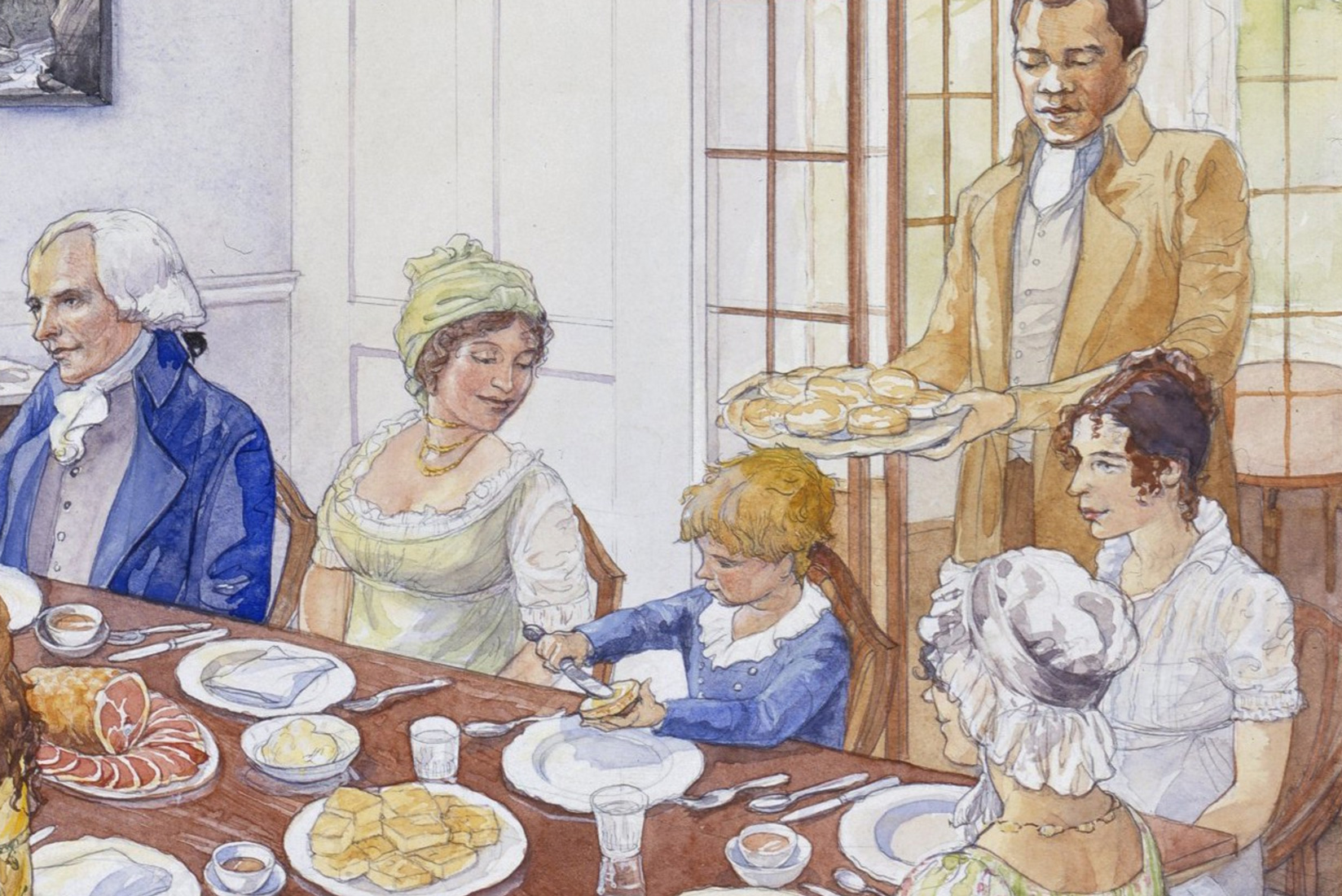Muffins

Watercolor by Gail McIntosh depicting Benjamin Franklin Randolph at breakfast demonstrating to Dolley Madison and others how to prepare one of the muffins being delivered on a tray by enslaved butler Burwell Colbert
Muffins feature frequently in the cuisine of Monticello. The following muffin recipe was recorded in the manuscript cookbook of Thomas Jefferson's granddaughter Septimia Anne Randolph Meikleham
To a quart of flour put two table spoons full of yeast. Mix . . . the flour up with water so thin that the dough will stick to the table. Our cook takes it up and throws it down until it will no longer stick [to the table?] she puts it to rise until morning. In the morning she works the dough over . . . the first thing and makes it into little cakes like biscuit and sets them aside until it is time to back them. You know muffins are backed in a gridle [before?] in the [fire?] hearth of the stove not inside. They bake very quickly. The second plate full is put on the fire when breakfast is sent in and they are ready by the time the first are eaten.[1]
Monticello staff members have modernized the above muffin recipe for today's bakers, as follows:
Modern Day Monticello Muffins
4 cups of flour
1 1/2 packets of yeast
1 1/2 cups of water
cast iron griddle
Mix the flour, yeast, and water. The dough will be very sticky. Coat your hands in flour before kneading the dough. While kneading, continue to add small amounts of flour to the dough until the stickiness disappears and the dough becomes more solid. You may find you add as much as 1/2 cup more flour during this process.
Put the dough in a large bowl, cover the bowl with a tea towel, and leave it in a warm place overnight. The dough should more than double by morning. The underside of the dough may be a little sticky – if so, knead it a bit more. Using your hands, shape the muffins into small golf-ball sized balls. Set the muffins aside, cover with a tea towel, and let rise for an hour.
Preheat ungreased griddle over medium heat. Add shaped muffins to the griddle and cook for about five minutes on each side.
The muffins will look like biscuits on the outside and English muffins on the inside. Serve immediately. Makes two dozen small muffins.[2]
It may have been these muffins Jefferson was speaking of when he wrote to his daughter Martha in 1802, "pray enable yourself to direct us here how to make muffins in Peter’s method. my cook here cannot succeed at all in them, and they are a great luxury to me."[3]
It was also perhaps these very same muffins that featured in the following story about a breakfast at Monticello, remembered by Ellen Wayles Harrison, a great-granddaughter of Thomas Jefferson:
On one occasion little Benjamin Franklin [Randolph] . . . seated next to Mrs. M[adison], found himself unequal to the management of his muffin. Mrs. Madison's aid being invoked, she took the knife to cut it, but a little hand was laid on hers, and an earnest voice exclaimed, "No! No! That is not the way!" "Well, how then Master Ben?" "Why, you must tear him open, and put butter inside and stick holes in his back! And then pat him and squeeze him and the juice will run out!" Mrs. Madison, much amused, followed his directions. Any lover of the English muffin will appreciate their wisdom![4]
- Anna Berkes, 9/20/19
Further Sources
- Fowler, Damon Lee, ed. Dining at Monticello: In Good Taste and Abundance. Charlottesville, VA: Thomas Jefferson Foundation, 2005. See page 91 for an adapted "Monticello Muffin" recipe.
- Randolph, Mary. The Virginia House-Wife. Washington, D.C.: Davis & Force, 1824. See page 169 for Mary Randolph's muffin recipe.
References
- ^ Septimia Randolph Meikleham Cookbook, Thomas Jefferson Foundation.
- ^ Developed from the original recipe by Monticello staff members Susan McCrary and Katherine G. Revell.
- ^ Jefferson to Martha Jefferson Randolph, November 2, 1802, in PTJ, 38:623. Transcription available at Founders Online.
- ^ Ellen Wayles Randolph Harrison, "Monticello Child Life; or, memories of what we heard from our parents, E.W. Harrison & M.J.T. Burke," transcribed by Martha Jefferson Trist Burke, 1888. Jefferson Library, Thomas Jefferson Foundation, Charlottesville, VA.